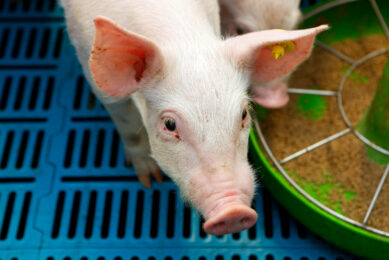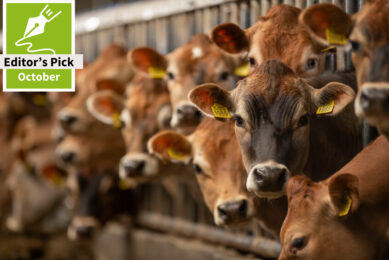Intestinal health: Feeding the microbiota to improve production

Intestinal health is an important determinant of animal performance and health. Increased efforts in monitoring gene expression and microbial composition are useful to improve nutritional strategies for animals and thus better understand the effect on intestinal health says Mark Geier.
By Mark Geier
The intestinal environment, which consists of the intestinal bacterial community (microbiota), the mucosal immune system, gut structure and gut function, affects host health and performance. As these aspects of the intestinal environment are all influenced by diet, a better understanding of the relationships between nutrition, the intestine and host health are important for optimising production. Within this article I will focus on the impact of diet on the intestinal microbiota, and the potential for the microbiota to influence animal health and production.
The microbiota
The importance of the intestinal microbiota and host–microbe crosstalk is highlighted by the results of studies conducted using germ-free animals. Animals reared under conditions that prevent bacterial colonisation display impaired intestinal immune system development and function (O’Hara and Shanahan, 2006). This demonstrates that there is a symbiotic relationship between the host and the microbiota. The intestinal microbiota is a highly complex milieu of over 600 species, which may be present at levels of up to 1011 colony-forming units of bacteria per gram of intestinal contents (Apajalahti et al., 2004). The characterisation of intestinal microbial communities has progressed rapidly in recent years as DNA-based profiling technologies have verified and replaced traditional culture-based techniques, which can only be applied to a small proportion of the bacteria present in the gut. A healthy microbiota is crucial for the health of the host. As intestinal bacteria metabolise 10–20% of dietary nutrients, they must convey beneficial effects to the host to justify this energy loss (Apajalahti et al., 2004). The microbiota also degrades polysaccharides that are not digestible by the host, thus increasing the nutritive value of the diet (Choct, 2009). The roles of the microbiota in pathogen exclusion and the synthesis of vitamins, minerals and other biologically active compounds are well documented (Patterson and Burkholder, 2003).
The effect of nutrition
The link between nutrition and the microbiota is well established. The composition of the intestinal microbiota is affected by grain type (Shakouri et al., 2008), dietary fat content (Knarreborg et al., 2002), feed form (Engberg et al., 2002) and non-starch polysaccharide degrading enzymes (Torok et al., 2008). The inclusion of antibiotics in diets also has a pronounced effect on bacterial communities, as do a range of compounds and organisms that have been identified as candidate antibiotic replacements (probiotics, prebiotics, bacterial products, short- and medium-chain fatty acids, plant extracts and other antibacterial compounds). The next challenge is to improve our understanding of how these components influence the microbiota and to devise feeding strategies to shift the composition of the microbial population.
Mechanism of antibiotics
Sub-therapeutic levels of antibiotics are used in some livestock industries to prevent disease and improve performance. The exact mechanism of action of in-feed antibiotics is not known; however, direct antimicrobial and non-antimicrobial anti-inflammatory mechanisms have been postulated (Niewold, 2007). In-feed antibiotic supplementation has been shown to significantly alter the composition of the host intestinal microbiota. For example, Engberg et al. (2000) reported that zinc bacitracin decreased numbers of ileal coliforms in poultry, whereas zinc bacitracin and salinomycin decreased Clostridium perfringens and Lactobacillus salivarius numbers. Using a molecular approach (terminal-restriction fragment length polymorphism analysis; T-RFLP) to provide a snapshot of the microbiota, Geier et al. demonstrated that zinc bacitracin changed the overall ileal microbial profile. Wang et al. (2007) saw that a flavomycin and aureomycin mix significantly decreased intestinal E. coli and Salmonella populations in pigs.
Probiotic induced changes
Probiotics are live organisms that, when ingested in sufficient quantities, convey a health benefit on the host (Shanahan, 2004). Common probiotics include members of the Lactobacillus and Bifidobacterium genera and organisms such as Saccharomyces cerevisiae. The efficacy of single-strain and multi-strain probiotics for livestock has been investigated. The beneficial properties of probiotics include removal or competitive exclusion of pathogens, enhanced immune system development and responsiveness and the production of beneficial compounds and metabolic by-products (Patterson and Burkholder, 2003). Numerous probiotic strains have been tested for use for poultry in terms of their capacity to improve performance, prevent pathogenic colonisation and improve immunity. Probiotics such as L. johnsonii, Bacillus subtilis and a multi-strain lactobacillus product modified the intestinal microbiota by reducing levels of pathogenic bacteria such as Salmonella enteritidis and C. perfringens (La Ragione and Woodward, 2003; La Ragione et al., 2004; Higgins et al., 2008). Additionally, a multi-strain probiotic significantly increased numbers of lactobacilli and bifidobacteria in the caeca of broilers (Mountzouris et al., 2007). Inclusion of L. sobrius in pig diets significantly decreased E. coli F4 levels (Konstantinov et al., 2008), and a multi-strain probiotic containing L. acidophilus, L. bulgaricus, B. subtilis and S. cerevisiae significantly increased ileal and colonic bifidobacteria levels and decreased levels of colonic coliforms (Shim et al., 2005). Evidence for probiotic-induced changes in the composition of the microbiota of sheep has also been reported, as a probiotic mixture increased faecal bacillus levels (Kumagai et al., 2004).
Prebiotics as substrate
Although it has been demonstrated that probiotics have the capacity to modify the composition of the microbiota, the administration of one or a small number of strains may not be the most effective means of promoting large-scale changes in microbial populations. Therefore, prebiotics are an alternative to probiotics. Prebiotics are non-digestible feed ingredients that influence the microbiota in a manner favourable for host health (Patterson and Burkholder, 2003). Prebiotics provide substrates for microbial fermentation in the gut, which results in the production of short chain fatty acids, an energy source for enterocytes. Many prebiotics, including fructooligosaccharide and mannanoligosaccharide, increase levels of beneficial bacteria such as bifidobacteria and lactobacillus and decrease levels of pathogens such as Escherichia coli (Fukata et al., 1999; Xu et al., 2003; Baurhoo et al., 2007). Recently, Geier et al. (2009) used T-RFLP and denaturing gradient gel electrophoresis analysis to demonstrate that fructooligosaccharide and mannanoligosaccharide affect the composition of the bacterial population and lactobacillus species profiles in broiler chickens. Interestingly, these microbial changes did not affect performance, indicating that numerous microbial compositions may facilitate a high level of performance under these conditions.
Other compounds
Both short- and medium-chain fatty acids possess antimicrobial properties and influence the composition of the microbiota (Chaveerach et al., 2004; Solis de Los Santos et al., 2008). Short chain fatty acids are produced by fermentation of indigestible oligosaccharides and may alter the pH of the intestinal environment, changing the relative proportions of susceptible bacteria, including Salmonella and C. perfringens (Chaveerach et al., 2004; Van Immerseel, 2006). Medium chain fatty acids have potent antimicrobial properties in vitro and in vivo. For example, lauric acid has been shown to target C. perfringens (Skrivanova et al., 2005), whereas caprylic acid is effective against E. coli (Marounek et al., 2003) and Campylobacter jejuni (Solis de Los Santos et al., 2008).
Many plants produce chemicals with therapeutic and protective properties, the isolation and concentration of which may produce potent compounds that could potentially improve animal health and performance. Examples of potentially beneficial plant extracts include polyphenolics (Jain et al., 2008), plant-derived polysaccharides (Guo et al., 2004), essential oils (Quigley, 2007) and saponins (Cheeke, 2009). Plant extracts have been reported to alter the composition of the microbiota in poultry (Guo et al., 2004) and pigs (Castillo et al., 2006).
Immuno-modulatory compounds such as lactoferrin may also affect the microbiota. Geier et al. (2009b) showed that lactoferrin affected the bacterial community in the caecum of poultry. In pigs, lactoferrin increased numbers of lactobacillus and bifidobacteria and decreased numbers of E. coli and salmonella (Wang et al., 2007). Other compounds, including bacterial products such as bacteriocins (Shin et al., 2008) and immuno-modulatory compounds may also play an important role in modifying the intestinal microbiota.
Finding the optimum
As it is now known that diet can affect the microbiota, the next challenge is to identify the composition of the optimal microbiota and devise additive-based feeding regimens that consistently facilitate the establishment and maintenance of an optimal microbial composition. Although the key pathogens and compounds that eliminate them are known, further knowledge on organisms that are important for optimal health and performance is required. Common probiotic bacteria such as bifidobacteria and lactobacillus would certainly constitute part of an optimal microbiota, but other microbes, including previously unidentified organisms, may have equal or greater importance in maintaining an optimal intestinal bacterial community. To date, most studies on dietary additives have relied on culture-based techniques to quantify bacteria. A recent study, in which the DNA-based technique, T-RFLP, was employed, linked the composition of the gut microbial population with differences in energy metabolism among broiler chickens (Torok et al., 2008). This demonstrates the value of these and other molecular techniques such as denaturing gradient gel electrophoresis for monitoring the microbiota. Microbial profiling, coupled with in-depth analysis of the mucosal immune system, intestinal mucin dynamics, microbial activity, gut structure and gene expression will improve our understanding of the impact of nutrition on the intestinal environment, interactions between aspects of the intestinal environment and subsequent effects on animal health and performance. This may result in definition of an optimal intestinal environment and development of dietary means of consistently facilitating the establishment of such an environment.
Microbial genome is important
Microbial gene expression and metabolic activity underlie the effects of a microbe on its environment, other bacteria and the host. Thus, factors rather than microbial composition alone should be considered when studying relationships between diet, the microbiota and host health. The genome of the intestinal microbiota, the microbiome, may contain up to 100 times more genes than the host, some of which may be responsible for metabolic functions that the host cannot perform (Salminen et al., 2005). Microbiomics, the study of microbial gene expression, is a means of studying functional, nutrient-mediated changes in microbial activity. An understanding of how external factors, including nutrition, affect the expression of microbial genes is important for optimising host health and performance. The genetic codes of a number of commensal bacteria, including L. acidophilus (Altermann et al., 2005) and L. johnsonii (Pridmore et al., 2004), have recently been sequenced; this will facilitate future studies on microbial gene expression and improve our understanding of interactions between the host and the microbiome. Salminen et al. (2005) demonstrated that some commensal bacteria lack genes for the production of vital co-factors and vitamins, indicating that they rely on other species or the host for these compounds. Additionally, anaerobic bacteria that inhabit the colon possess more genes involved with oligosaccharide metabolism and transport than microbes which colonise more proximally, signifying their possible adaptation to a specific ecological niche (Salminen et al., 2005). Adaptation to an environment may also be evident in bacteroides species, which decrease host immune recognition and responses by altering their surface polysaccharide structures (Salminen et al., 2005). Microbial activity can be altered without significantly influencing the composition of the microbiota (Rehman et al., 2008). Conversely, different microbial profiles induced by different conditions such as the presence or absence of other organisms or nutrients may have similar metabolic activities. This complicates elucidation of the effect of the microbiota on host health and performance. Metabolomic and genomic studies on the intestinal microbiota and assessment of responses to dietary manipulation will be important in this respect.
Problems and future strategies
Although this field of research has potential for preventing pathogenic infections and optimising animal performance, there are many unknowns and potential complications. Future research in this area should consider the following questions:
• What is an optimal microbiota?
• Does an optimal microbiota exist, or are many microbial compositions able to facilitate a high level of performance?
• Can a particular diet consistently facilitate the establishment of an optimal microbiota?
• To what extent do non-dietary factors such as management, host gene expression and the intestinal environment affect the development and establishment of the microbiota?
• How variable are individual animal responses to diet-induced microbial manipulation?
• Is the establishment of an environment conducive to optimal microbial activity and gene expression more important than the identification of optimal microbial composition?
• Will a microbial composition conducive to improved growth performance in healthy animals also be ideal for disease resistance, or will an “optimal” microbiota be a compromise between performance and disease resistance?
Host – microbe crosstalk
The intestinal microbiota and host gene expression within the intestine are interlinked and it is clear that significant bi-directional host–microbe crosstalk occurs (Bedford and Apajalahti, 2001; Kelly and King, 2001; Hooper et al., 2002). This crosstalk may be mutually beneficial, facilitating the establishment of the bacterium in a potentially competitive environment, improving the development of the host intestinal environment, and maximising the nutritional value of the diet. An example of such crosstalk is the interaction between Bacteroides thetaiotaomicron and the intestinal epithelium in mice (Hooper et al., 2001). B. thetaiotaomicron has the capacity to colonise the intestine, signal the host and affect the expression of host genes involved in control of maturation, nutrient uptake and metabolism (Hooper et al., 2001) and induce the host to secrete products that provide an energy source for the bacterium (Hooper et al., 2002). Host–microbe crosstalk is important for the health of the animal and the microbiota; therefore, it is important to consider the effect that dietary additives have on this relationship. Dietary factors that affect the microbiota often affect other aspects of the intestinal environment such as immunity (Brisbin et al., 2008a; Brisbin et al., 2008b; Janardhana et al., 2008), intestinal mucin expression (Smirnov et al., 2005), gut microarchitecture (Iji et al., 2001) and digestive enzyme expression (Iji et al., 2001). Smirnov et al. (2005) showed that in-feed probiotic supplementation simultaneously increased levels of intestinal lactobacillus species and altered mucin gene expression. Janardhana et al. (2008) and Geier et al. (2008, 2009a) reported simultaneous prebiotic- and antibiotic-mediated microbial and immunological changes in broilers. Further investigation is required to determine how host–microbe interactions affect these changes.
Conclusions
The intestine harbours a highly complex milieu including the microbiota, immune system and mucosa. Host and microbial gene expression underlie key processes associated with health and productivity and affect one another via host–microbe crosstalk. Nutritional factors influence the intestinal environment, which subsequently affects health and performance. A multi-faceted approach encompassing studies of the effect of nutrition on the intestinal environment and host–microbe crosstalk will improve our understanding of key pathways associated with health and performance. This task is complex and will require sophisticated analytical techniques and multi-disciplinary collaboration involving traditional sciences such as nutrition, physiology, biochemistry and immunology and the new fields of nutrigenomics, metabolomics and microbiomics.
Source: FeedMix vol 17 nr 6, 2009











